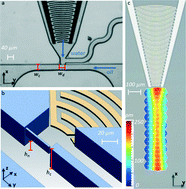On-chip droplet production regimes using surface acoustic waves†
Abstract
Aqueous droplets suspended in an immiscible carrier fluid are a key tool in microfluidic chemical analysis platforms. The approaches for producing droplets in microfluidic devices can be divided into three general categories: batch emulsification, continuous production and tailored on-demand production. The major distinctions between each category are the rate of production and the degree of control over the droplet formation process in terms of the size and quantity. On-demand methods are highly desirable when, for example, small numbers or even single droplets of one sample type are required at a time. Here, we present a method for the on-demand production of femtolitre droplets, utilising a pressure source generated by high frequency surface acoustic waves (SAW). An increase in the continuous phase flow rate is enabled by a quasi-3D feature at the droplet production nozzle. A wide range of accessible flow rates permits the identification of different physical regimes in which droplets of different dimensions are produced. In the system investigated droplets measuring as little as 200 fl have been produced, ∼1/60th of the minimum volume previously reported. The experimental findings are supported by a numerical model which demonstrates the link between the number of droplets formed and the pulse length used.


 Please wait while we load your content...
Please wait while we load your content...